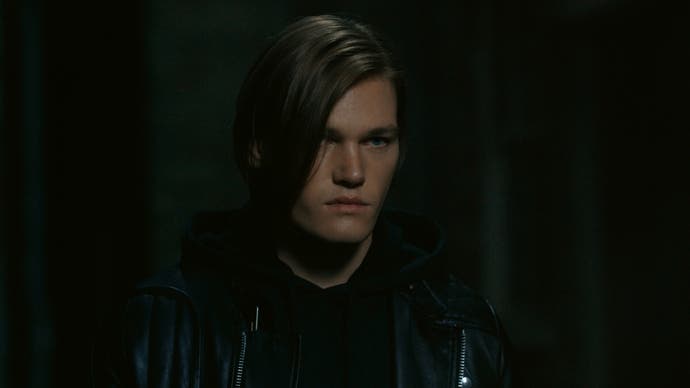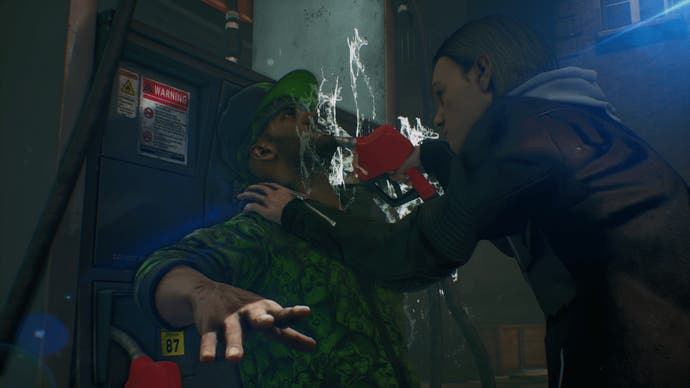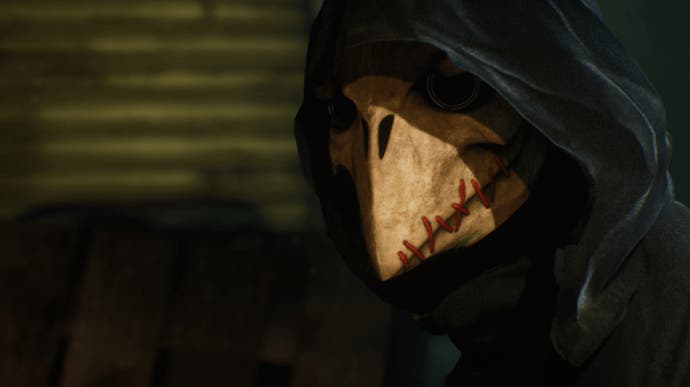The Quiet Man review - a juvenile, incompetent embarrassment
Hush now.
It's hard to know where to start with this misbegotten game, a short interactive drama with a deaf protagonist and live-action sequences that succeeds only in replicating the experience of flicking between the Starz channel and a substandard PS2 brawler with the TV on mute. It is a terrible idea, poorly executed, which is insulting to the hard of hearing as well as the time of everyone who plays it.
The Quiet Man tells the story of Dane, a moody young deaf man with a biker jacket, because he is tough, and a curtain of emo hair, because he is tortured. (Or perhaps because it's the same hairstyle sported by the Square Enix producer, Kensei Fujinaga, whose brainchild this game is.) He maybe works for a local crime lord; at any rate, he spends his time beating up ludicrously attired gangsters in alleyways and delivering briefcases full of drugs to a slick operator called Taye. When he was a child he witnessed the shooting of a woman who was probably his mother, and this made him very angry. He seems to blame another crime boss for the woman's death. There is also a woman who looks identical to his mother, but seems to be a different person. She's a singer at a local nightclub, and is possibly Taye's girlfriend, though everyone is weird about this. Dane spends a lot of time staring beatifically at her until she is kidnapped by a man in a bird mask and a hooded cape, abetted by the gangsters in silly clothes. This uncocks his fountain of adolescent rage and he sets off to find out what happened to his apparent Oedipal crush. For some reason that's hard to pin down, this makes Taye very angry, too.
If I am unreasonably vague on the details of this very simple plot, it's because The Quiet Man, in supposed empathy with its lead character, plays out near-soundlessly, so you can't hear any of the dialogue in what is an extremely dialogue-heavy two-to-three hours. There are moody musical cues, and you hear a muffled, distant chiming sound when characters speak. Dane's physical sense of the world is rendered more forcefully, with taps and booming thuds replicating a touch on the shoulder, a footstep, a punch.

This sound design is quite effective - it's dreamlike and alienating, as is surely the intention, giving you a sense of Dane's disconnection from a world that excludes him. But as a simulation of a deaf person's experience, the overall approach taken by The Quiet Man is tokenistic, illogical and exploitative, employing its soundlessness as a coy narrative gimmick that is, in itself, a dismal failure.
Dane is shown using sign language, but no translation is offered for players who might not understand it. It seems as if he can lip read, at least to some extent - he converses a little bit with other characters, and seems to understand what they're saying to him - but we are not even offered a partial understanding of it, which could have been done via subtitles. It might be possible for lip-readers to follow the live-action scenes, but certainly not the animated ones. For that matter, we don't even hear or understand what Dane says himself. And why on earth does the lack of sound persist in the few brief scenes where Dane is not present?
None of this makes any sense. If the producers at Square Enix and the developers at Human Head Studios (hired hands, I assume) truly wanted us to share Dane's experience, they would have let us in on his thoughts, his motivations and his understanding, however limited, of what was being said. Instead, his deafness is exploited for a manipulative trick on the player, creating obfuscation and mystery around a story that hasn't earned it. If this was intended to draw us in, the tactic fails miserably, because the result is confusion and deep boredom as another corny noir scenario plays out mutely on the screen. The visual storytelling is not nearly strong enough to make up for this narrative vacuum.
But wait, the manipulation gets crasser still. The Quiet Man promises that a playthrough with the soundtrack restored will both resolve and deepen the mystery around its storyline. But this privilege is not only withheld until you have endured the game without sound once; it has been held back until a week after release, for no reason but to string players along and manufacture more unwarranted and unearned suspense. It's an insulting way to treat people who've bought the game and it's offensive to use a disability as the hook to hang this cheap ploy on.
I probably should have waited until the soundtrack was released before writing this review (only a couple of days away, at time of writing). But I can already tell that it won't be worth the wait or the scant time it will take to replay. Some details of the plot will be resolved, no doubt, and perhaps some light shed on the sudden non-sequiturs, continuity breaks and risible twists during the concluding act, when up to four different characters seem to be revealed as the true identity of the masked bird man. But even in this garbled form, the shape of the story can be made out clearly enough to tell that it is embarrassingly juvenile. The conflation of Dane's mother-figure and love interest in a single woman - the only woman in the game, of course - is enough to make you cringe, and that's before she/they is/are simultaneously fridged and damselled to motivate his adolescent eruption of violence.
About that violence: the interactive part of this interactive drama is not, as it usually is, a bit of detective work or a few branching conversations. It is a basic brawler in which Dane takes on waves of thugs, punching, kicking and evading with simple combos. There's a 'focus' mode that unleashes 'beatdowns' and is crucial to success, but it goes completely unexplained by the game and it will be a while before you cotton on to the subtle audiovisual cues that it's available. The fighting system is unsophisticated but fine - or it would be were it not for a glitchy and inept camera that regularly fails to keep Dane, never mind his opponents, in shot. It's essential to play on easy so you don't need to actually concentrate on the fighting - although, in the deliberate absence of the story, that leaves nothing left to concentrate on.

The Quiet Man boasts one remarkable achievement: there's a surprisingly strong visual consistency between the live-action and game-engine scenes. Human Head's artists have done wonders to get the lighting to match, in particular. I can't think of a reason, other than budget, why some dialogue cut-scenes play out in live action and some in animation. It's a jarring inconsistency, but not nearly so damaging to the game's integrity as the wooden animation when the player takes control, or the unfortunately sparse number of repeating character models among your opponents. The overall effect is of a game slaloming drunkenly from one side of the uncanny valley to the other without ever climbing out of it.
What a mess. Fujinaga says The Quiet Man was made with an "indie" spirit, by which I take him to mean its short running time, lower price point, experimental approach and narrative leaning. But you could not find a better example of corporate vanity art blundering, with almost comical hubris and insensitivity, into areas it is woefully unequipped to handle.



